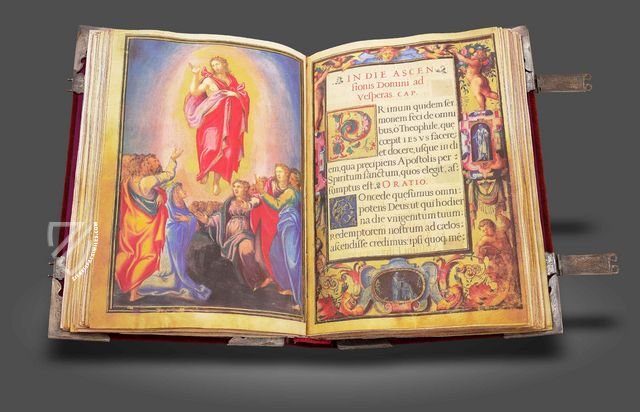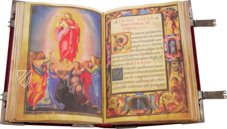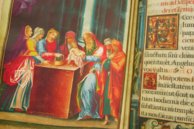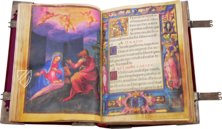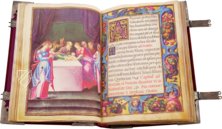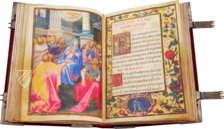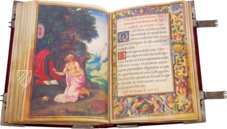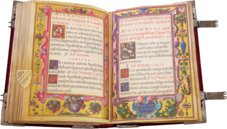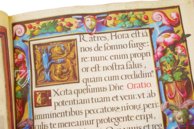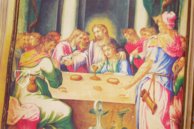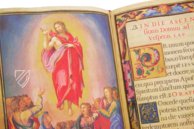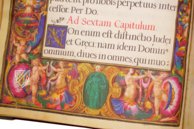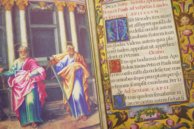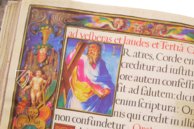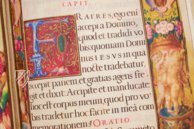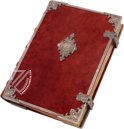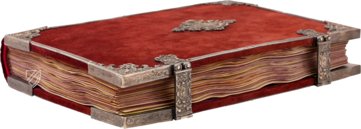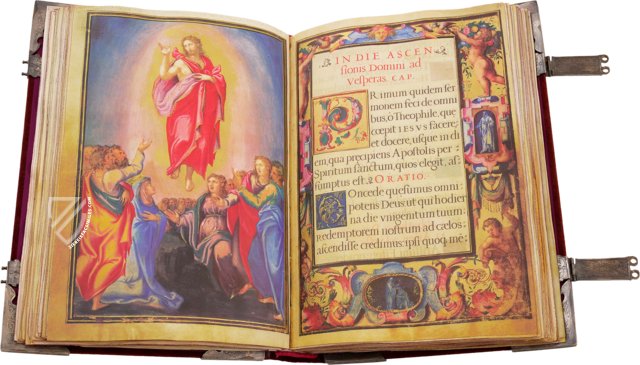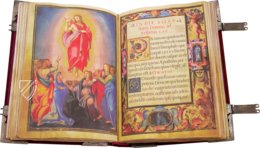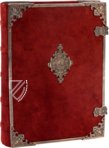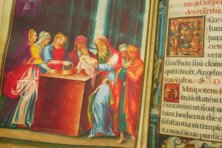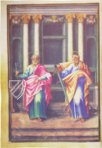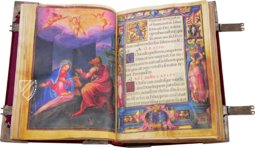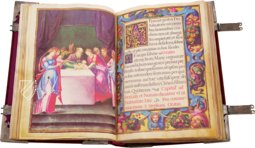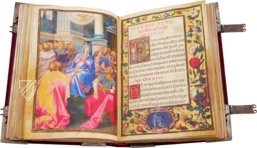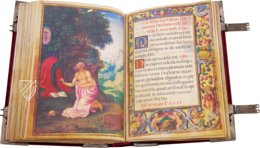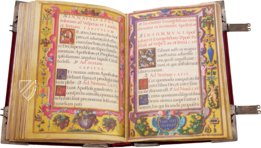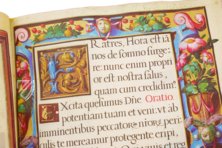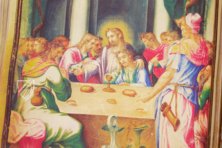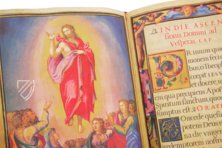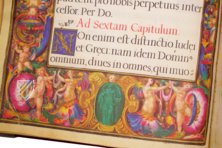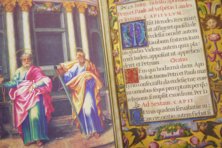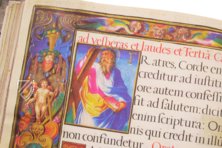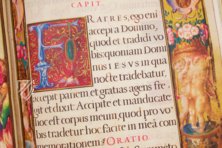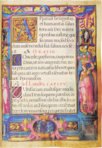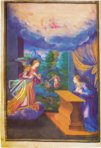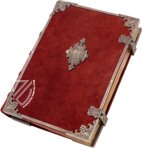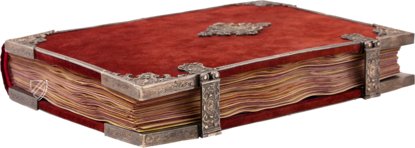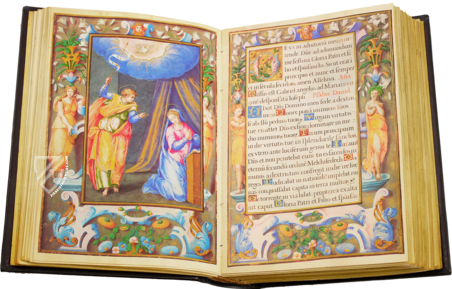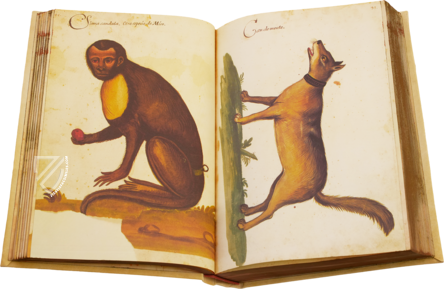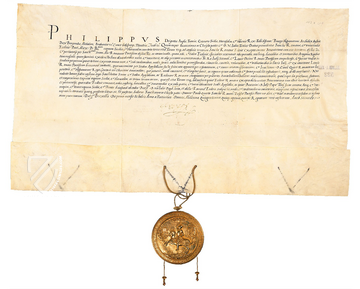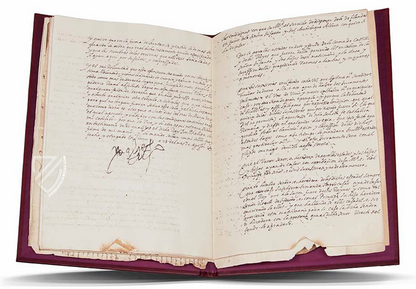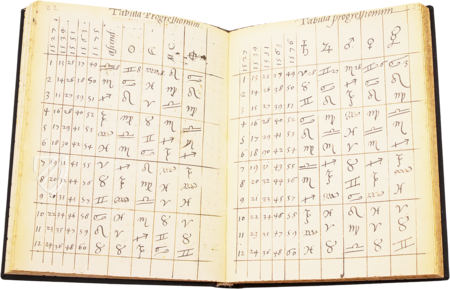Prayerbook of Philip II
(3,000€ - 7,000€)
The prayerbook belonging to King Philip II impresses with wonderful, stylish miniatures that are perfectly executed artistically as well as the rich, creative design of the pages of text and imagery. Philip II, the significant Spanish King and builder of the royal monastery of San Lorenzo de El Escorial, commissioned the private devotional book. Two Spanish monks – Andrés de León and Julián de Fuente el Saz – oriented themselves on the style of Italian role models like Giulio Clovio in creating this masterpiece. The religious depictions and ornamental bordures unite the most luminous colors and noble gold with fantastic miniature painting in the Prayerbook of Philip II, making it one of the gems of the monastic library of El Escorial.
Prayerbook of Philip II
During the 16th century, the last and most marvelous flowering of manuscript culture occurred at the same time that book printing became ubiquitous across Europe. The highest-ranking members of the European nobility still favored handmade codices over printed ones and some true masterpieces of illumination were produced during this time as a result. Created at the behest of the famous Spanish king and patron of the arts, the Prayerbook of Philip II was created by a team of Spanish artists who were inspired by the refinement and creativity of Giulio Clovio (1498–1578). The structure of the book is divided into three sections: first, a religious calendar with columns for the Numerus Aureus, Sunday Letter, Roman Calendar, and a saints’ calendar; second, a Sequuntur Capitula et orationes posite in psalterio followed by the liturgical prayers to be said in the royal chapel; third, a magnificent miniature of the Holy Burial followed by prayers for the deceased relatives of King Philip II.
The Royal Patron
In the years 1563-1585, King Philip II (1527-1598) had a royal monastery of incredible proportions built on a hill amidst a wide, barren landscape not far from Madrid. To this day, the monastery complex of San Lorenzo de El Escorial belongs among the most impressive edifices of 16th century Spain. The significant library with the great hall under a barrel vault decorated with wonderful frescoes is also one of the monuments created by Philip II. Numerous manuscripts have been housed in the library since the time of Philip II including some true treasures of illumination.
A Spanish Work of Art in the Italian Style
Not only does the Prayerbook of Philip II have 19 full-page miniatures, all 324 pages of the royal manuscript are opulently designed with decorative ornamentation and furnished with gilded initials. The private devotional book, with an unusually large format of 33.5 x 23 cm, offers an unbelievably colorful impression at first sight. The Hieronymites Andrés de León and Julián de la Fuenta el Saz were the artists responsible for the manuscript; their miniatures, frames, and initials are reminiscent of the fantastic art of Giulio Clovio in their perfection.
Airy Miniatures Alongside Ornamental Bordures
The biblical scenes of the miniatures play out above and before airy green landscapes and interior spaces designed with a strict perspective. The figures in colorful, lightly draped garments are extremely animated and lovingly individualized. The large-format miniatures are surrounded by broad bordures, which also adorn some pages of text. Tasty fruits and splendid blossoms alternate in the décor with playful cherubs and other ornaments. Some of the pages are designed in a restrained yet noble manner with monochrome frames and bewildering golden ornaments, in which wonderful medallions with monochrome depictions of saints are embedded. The initials of the text are also furnished with gold in accordance with the overall artistic design. The Prayerbook of Philip II represents an outstanding attestation of 16th century Spanish illumination and, with its artistic décor of the highest quality, is worthy of a royal owner.
Codicology
- Alternative Titles
- Capitulario de Felipe II
Gebetbuch Philipps II. - Size / Format
- 324 pages / 33.5 × 24.0 cm
- Origin
- Spain
- Date
- 1568–1580
- Epochs
- Style
- Genre
- Language
- Script
- Humanistic Rotunda
- Illustrations
- 19 full-page miniatures and numerous ornamental pages in the Renaissance style with decorative initials
- Content
- Religious calendar, prayers for mass in the royal chapel, prayers for Philip II's deceased relatives
- Patron
- Philip II, King of Spain (1527–1598)
- Artist / School
- Martín de Palencia (sribe)
Andrés de León (illuminator)
Julián de la Fuente el Saz (illuminator)
Ambrosio de Salazar (illuminator)
Juan de Salazar (illuminator)
Prayerbook of Philip II
The Holy Trinity
This wonderfully detailed and artfully executed medallion miniature preceding a text page depicts the Holy Trinity. God the Father sits on the right wearing a crown, holding a globus cruciger or “cross-bearing orb”, and making the sign of the benediction. Christ sits on the left holding the cross with one hand and grazing the wound in his side with the other. A white dove representing the Holy Spirit hangs in the air above them as though it were about to fly out from the page.
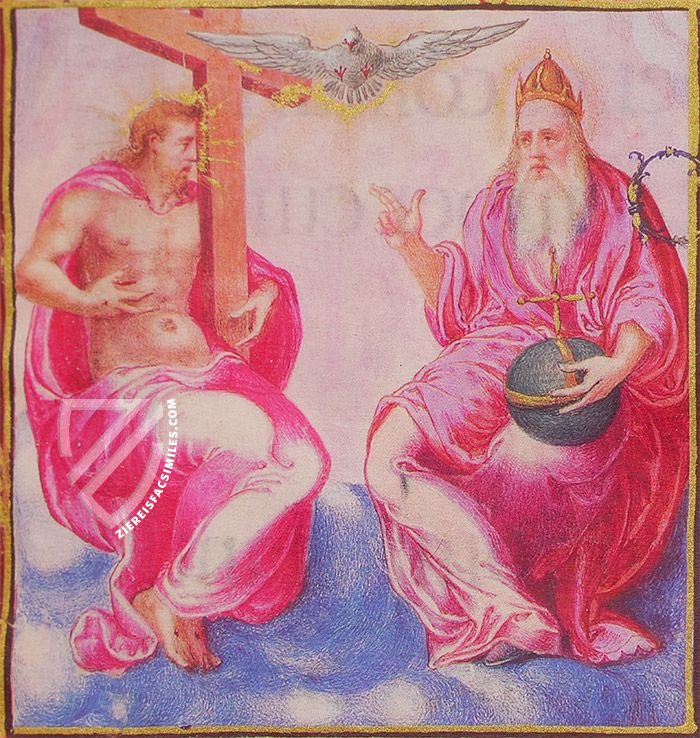
Prayerbook of Philip II
The Feast of Saints Peter and Paul
Two of the most important figures of the early Church are depicted in front of a symmetrical classical architecture including fluted columns and golden capitals with flowering garlands suspended between them. The symmetrical, tripartite organization of the miniature shows each figure standing in front of two columns and between three niches. Their shared feast is celebrated on June 29th.
Holding the keys to the kingdom of heaven, Peter assumes the primary position in the hierarchical order, standing on the left, which would be on the right when looking out from the altar. Paul holds the sword of his martyrdom and in contrast to Peter, who looks straight ahead, his face is shown in profile. Both men have curly hair, fluffy beards, and golden halos.
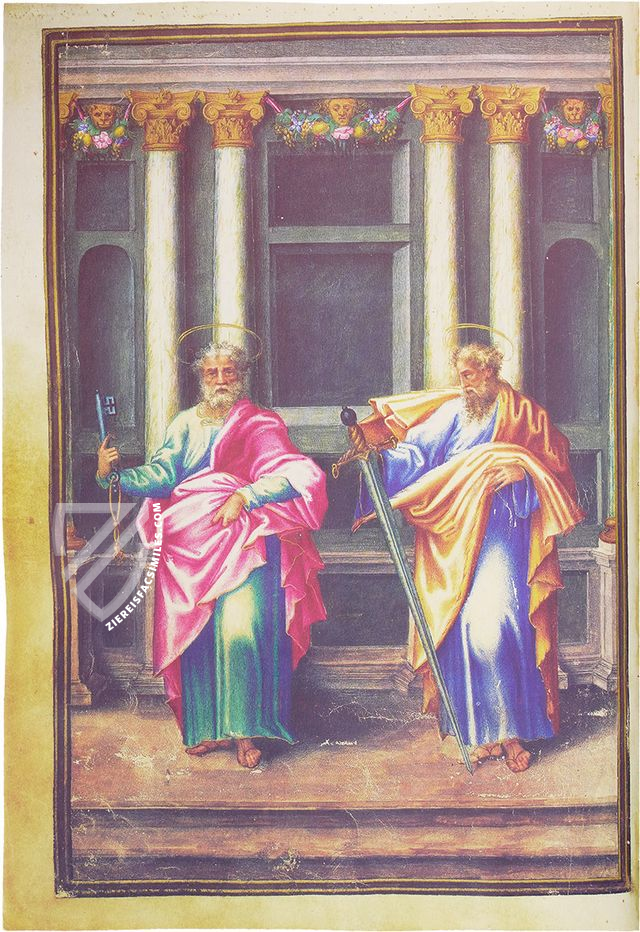
#1 Capitulario de Felipe II
Language: Spanish
(3,000€ - 7,000€)
- Treatises / Secular Books
- Apocalypses / Beatus
- Astronomy / Astrology
- Bestiaries
- Bibles / Gospels
- Chronicles / History / Law
- Geography / Maps
- Saints' Lives
- Islam / Oriental
- Judaism / Hebrew
- Single Leaf Collections
- Leonardo da Vinci
- Literature / Poetry
- Liturgical Manuscripts
- Medicine / Botany / Alchemy
- Music
- Mythology / Prophecies
- Psalters
- Other Religious Books
- Games / Hunting
- Private Devotion Books
- Other Genres
- Afghanistan
- Armenia
- Austria
- Belgium
- Belize
- Bosnia and Herzegovina
- China
- Colombia
- Costa Rica
- Croatia
- Cyprus
- Czech Republic
- Denmark
- Egypt
- El Salvador
- Ethiopia
- France
- Germany
- Greece
- Guatemala
- Honduras
- Hungary
- India
- Iran
- Iraq
- Israel
- Italy
- Japan
- Jordan
- Kazakhstan
- Kyrgyzstan
- Lebanon
- Liechtenstein
- Luxembourg
- Mexico
- Morocco
- Netherlands
- Palestine
- Panama
- Peru
- Poland
- Portugal
- Romania
- Russia
- Serbia
- Spain
- Sri Lanka
- Sweden
- Switzerland
- Syria
- Tajikistan
- Turkey
- Turkmenistan
- Ukraine
- United Kingdom
- United States
- Uzbekistan
- Vatican City
- A. Oosthoek, van Holkema & Warendorf
- Aboca Museum
- Ajuntament de Valencia
- Akademie Verlag
- Akademische Druck- u. Verlagsanstalt (ADEVA)
- Aldo Ausilio Editore - Bottega d’Erasmo
- Alecto Historical Editions
- Alkuin Verlag
- Almqvist & Wiksell
- Amilcare Pizzi
- Andreas & Andreas Verlagsbuchhandlung
- Archa 90
- Archiv Verlag
- Archivi Edizioni
- Arnold Verlag
- ARS
- Ars Magna
- ArtCodex
- AyN Ediciones
- Azimuth Editions
- Badenia Verlag
- Bärenreiter-Verlag
- Belser Verlag
- Belser Verlag / WK Wertkontor
- Benziger Verlag
- Bernardinum Wydawnictwo
- BiblioGemma
- Biblioteca Apostolica Vaticana (Vaticanstadt, Vaticanstadt)
- Bibliotheca Palatina Faksimile Verlag
- Bibliotheca Rara
- Boydell & Brewer
- Bramante Edizioni
- Bredius Genootschap
- Brepols Publishers
- British Library
- C. Weckesser
- Caixa Catalunya
- Canesi
- CAPSA, Ars Scriptoria
- Caratzas Brothers, Publishers
- Carus Verlag
- Casamassima Libri
- Centrum Cartographie Verlag GmbH
- Chavane Verlag
- Christian Brandstätter Verlag
- Circulo Cientifico
- Club Bibliófilo Versol
- Club du Livre
- CM Editores
- Collegium Graphicum
- Collezione Apocrifa Da Vinci
- Comissão Nacional para as Comemorações dos Descobrimentos Portugueses
- Coron Verlag
- Corvina
- CTHS
- D. S. Brewer
- Damon
- De Agostini/UTET
- De Nederlandsche Boekhandel
- De Schutter
- Deuschle & Stemmle
- Deutscher Verlag für Kunstwissenschaft
- DIAMM
- Droz
- E. Schreiber Graphische Kunstanstalten
- Ediciones Boreal
- Ediciones Grial
- Ediclube
- Edições Inapa
- Edilan
- Editalia
- Edition Deuschle
- Edition Georg Popp
- Edition Leipzig
- Edition Libri Illustri
- Editiones Reales Sitios S. L.
- Éditions de l'Oiseau Lyre
- Editions Medicina Rara
- Editorial Casariego
- Editorial Mintzoa
- Editrice Antenore
- Editrice Velar
- Edizioni Edison
- Egeria, S.L.
- Eikon Editores
- Electa
- Emery Walker Limited
- Enciclopèdia Catalana
- Eos-Verlag
- Ephesus Publishing
- Ernst Battenberg
- Eugrammia Press
- Extraordinary Editions
- Fackelverlag
- Facsimila Art & Edition
- Facsimile Editions Ltd.
- Facsimilia Art & Edition Ebert KG
- Faksimile Verlag
- Feuermann Verlag
- Folger Shakespeare Library
- Franco Cosimo Panini Editore
- Friedrich Wittig Verlag
- Fundación Hullera Vasco-Leonesa
- G. Braziller
- Gabriele Mazzotta Editore
- Gebr. Mann Verlag
- Gesellschaft für graphische Industrie
- Getty Research Institute
- Giovanni Domenico de Rossi
- Giunti Editore
- Graffiti
- Grafica European Center of Fine Arts
- Guido Pressler
- Guillermo Blazquez
- Gustav Kiepenheuer
- H. N. Abrams
- Harrassowitz
- Harvard University Press
- Helikon
- Hendrickson Publishers
- Henning Oppermann
- Herder Verlag
- Hes & De Graaf Publishers
- Hoepli
- Holbein-Verlag
- Houghton Library
- Hugo Schmidt Verlag
- Idion Verlag
- Il Bulino, edizioni d'arte
- ILte
- Imago
- Insel Verlag
- Insel-Verlag Anton Kippenberger
- Instituto de Estudios Altoaragoneses
- Instituto Nacional de Antropología e Historia
- Introligatornia Budnik Jerzy
- Istituto dell'Enciclopedia Italiana - Treccani
- Istituto Ellenico di Studi Bizantini e Postbizantini
- Istituto Geografico De Agostini
- Istituto Poligrafico e Zecca dello Stato
- Italarte Art Establishments
- Jan Thorbecke Verlag
- Johnson Reprint Corporation
- Josef Stocker
- Josef Stocker-Schmid
- Jugoslavija
- Karl W. Hiersemann
- Kasper Straube
- Kaydeda Ediciones
- Kindler Verlag / Coron Verlag
- Kodansha International Ltd.
- Konrad Kölbl Verlag
- Kurt Wolff Verlag
- La Liberia dello Stato
- La Linea Editrice
- La Meta Editore
- Lambert Schneider
- Landeskreditbank Baden-Württemberg
- Leo S. Olschki
- Les Incunables
- Liber Artis
- Library of Congress
- Libreria Musicale Italiana
- Lichtdruck
- Lito Immagine Editore
- Lumen Artis
- Lund Humphries
- M. Moleiro Editor
- Maison des Sciences de l'homme et de la société de Poitiers
- Manuscriptum
- Martinus Nijhoff
- Maruzen-Yushodo Co. Ltd.
- MASA
- Massada Publishers
- McGraw-Hill
- Metropolitan Museum of Art
- Militos
- Millennium Liber
- Müller & Schindler
- Nahar - Stavit
- Nahar and Steimatzky
- National Library of Wales
- Neri Pozza
- Nova Charta
- Oceanum Verlag
- Odeon
- Orbis Mediaevalis
- Orbis Pictus
- Österreichische Staatsdruckerei
- Oxford University Press
- Pageant Books
- Parzellers Buchverlag
- Patrimonio Ediciones
- Pattloch Verlag
- PIAF
- Pieper Verlag
- Plon-Nourrit et cie
- Poligrafiche Bolis
- Presses Universitaires de Strasbourg
- Prestel Verlag
- Princeton University Press
- Prisma Verlag
- Priuli & Verlucca, editori
- Pro Sport Verlag
- Propyläen Verlag
- Pytheas Books
- Quaternio Verlag Luzern
- Reales Sitios
- Recht-Verlag
- Reichert Verlag
- Reichsdruckerei
- Reprint Verlag
- Riehn & Reusch
- Roberto Vattori Editore
- Rosenkilde and Bagger
- Roxburghe Club
- Salerno Editrice
- Saltellus Press
- Sandoz
- Sarajevo Svjetlost
- Schöck ArtPrint Kft.
- Schulsinger Brothers
- Scolar Press
- Scrinium
- Scripta Maneant
- Scriptorium
- Shazar
- Siloé, arte y bibliofilia
- SISMEL - Edizioni del Galluzzo
- Sociedad Mexicana de Antropología
- Société des Bibliophiles & Iconophiles de Belgique
- Soncin Publishing
- Sorli Ediciones
- Stainer and Bell
- Studer
- Styria Verlag
- Sumptibus Pragopress
- Szegedi Tudomànyegyetem
- Taberna Libraria
- Tarshish Books
- Taschen
- Tempus Libri
- Testimonio Compañía Editorial
- Thames and Hudson
- The Clear Vue Publishing Partnership Limited
- The Facsimile Codex
- The Folio Society
- The Marquess of Normanby
- The Richard III and Yorkist History Trust
- Tip.Le.Co
- TouchArt
- TREC Publishing House
- TRI Publishing Co.
- Trident Editore
- Tuliba Collection
- Typis Regiae Officinae Polygraphicae
- Union Verlag Berlin
- Universidad de Granada
- University of California Press
- University of Chicago Press
- Urs Graf
- Vallecchi
- Van Wijnen
- VCH, Acta Humaniora
- VDI Verlag
- VEB Deutscher Verlag für Musik
- Verlag Anton Pustet / Andreas Verlag
- Verlag Bibliophile Drucke Josef Stocker
- Verlag der Münchner Drucke
- Verlag für Regionalgeschichte
- Verlag Styria
- Vicent Garcia Editores
- W. Turnowski Ltd.
- W. Turnowsky
- Waanders Printers
- Wiener Mechitharisten-Congregation (Wien, Österreich)
- Wissenschaftliche Buchgesellschaft
- Wissenschaftliche Verlagsgesellschaft
- Wydawnictwo Dolnoslaskie
- Xuntanza Editorial
- Zakład Narodowy
- Zollikofer AG

